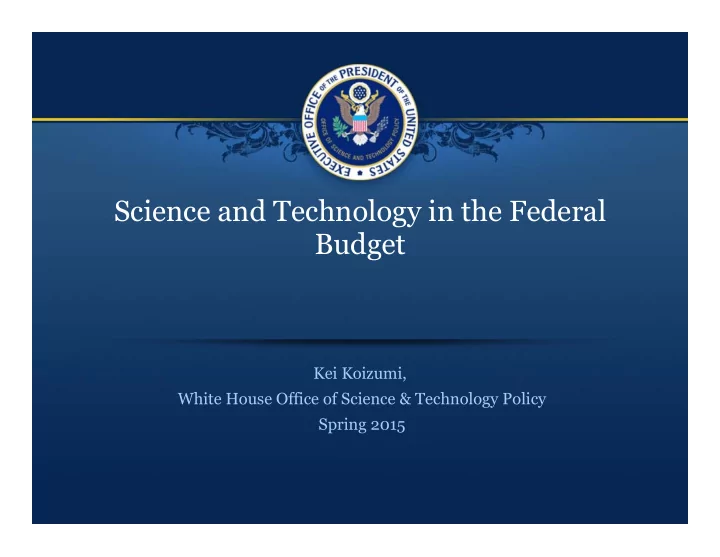

Science and Technology in the Federal Budget Kei Koizumi, White House Office of Science & Technology Policy Spring 201 5
Composition of the Proposed FY 2016 Budget Total Outlays = $4.0 trillion Net interest Defense discretionary {Defense R&D} Other mandatory Nondefense discretionary Medicaid {Nondefense R&D} Medicare Social Security February '15 OSTP
Composition of the Proposed FY 2016 Budget by Source of Funds Total Outlays = $4.0 trillion Borrowing Income taxes Other taxes (excise, gas, Total Receipts (without estate, etc.) borrowing): $3.5 trillion Social insurance and retirement (SS + Medicare payroll taxes) Corporate taxes FEBRUARY '15 OSTP
How the Budget Becomes Law FY 2016 Proposal = $4.0 trillion Net interest - automatic Discretionary Spending - 12 appropriations bills, plus war supplemental bill(s) from Appropriations Committees Entitlements - Reconciliation bill, other bills from $ various committees (such as Medicare drug Revenues - bill) (optional) Reconciliation bill, other bills from various committees (such as the Recovery Act) (optional) FEBRUARY '15 OSTP
Budget Timeline Now Calendar 11 12 13 14 15 16 Year Fiscal Year FY16 OMB/OSTP Priorities Memo 16 15 ‘16 Budget to Congress 14 Appropriation bill signed (or CR) Appropriation Formulation Negotiation Execution Agencies EOP � Agencies Congress Agencies + Performers
Is there an official definition for R&D ? • Yes. NSF keeps it. OMB and others’ definitions of R&D follow it, and the definitions are coordinated internationally. • “S&T” is not defined officially; neither is “innovation.” • NSF does annual surveys to measure U.S. R&D • OMB asks agencies to submit R&D funding data as part of the budget process
The FY 2015 Budget Process (1) Spring 2013 – Agencies begin to formulate their FY 2015 proposals. Summer 2013 – Agencies formulate their FY 2015 proposals based on broad strategic guidance from OMB (Office of Management and Budget) (and OSTP for science agencies). September 2013 – Agencies deliver their budgets to OMB. Agencies brief OMB (and OSTP, and other WH offices) on their budgets. Fall 2013 – Agencies negotiate with OMB over their FY 2015 proposals. OSTP has an advisory role. Agencies respond to OMB (and OSTP) questions. January 2014 – PASSBACK (decisions on agency budgets, including additions or subtractions to the original agency proposals; delayed from November). January– February 2014 – Appeals. If agencies are unhappy with their passbacks, they can appeal. OMB resolves appeals. (Appeals can go to the OMB Director, the West Wing, and in a few cases to the President.) February 2014 – Settlement. Agencies finalize their requests. OMB, OSTP, and agencies then work on finalizing budget documents. March 2014 – President releases his proposed FY 2015 budget and transmits it to Congress.
The FY 2015 Budget Process (2) Spring 2014 – Agency officials (including OSTP) and public witnesses testify at congressional budget and oversight hearings; authorizing committees try to write and pass authorization bills or offer formal ‘views and estimates’ on budgets. Appropriations committees also hold hearings. Spring-Summer 2014 – Congress approves its FY 2015 budget resolution, its big-picture budget plan. (Deadline: April 15. Not met.) - Appropriations committees receive 302(a) allocations from the budget resolution: total discretionary spending. -Appropriations committees determine 302(b) allocations dividing total discretionary spending among 12 bills. -House and Senate try to draft, debate, approve, and conference (compromise between House and Senate versions) 12 appropriations bills.
Discretionary Spending by Appropriations Bill FY 2015 Appropriations = $1.0 trillion Commerce, Justice, Energy-Water Science Financial Services Homeland Security Interior / Environment Defense Labor-HHS- Education Legislative Branch Mil. Construction / VA State and Foreign Ops. Agriculture Transportation / HUD Congressional Budget Office March 2015
The FY 2015 Budget Process (3) October 1, 2014 – FY 2015 begins. Discretionary programs must have a signed appropriations bill, or shut down. To allow more time, lawmakers pass continuing resolutions (CR’s). The 1 st CR extends through December 11. There is a 2 nd CR through December 13, and a 3 rd CR through December 17. December 13, 2014 – Congress approved a ‘cromnibus’ bill (an 11-bill omnibus appropriations bill plus a CR through February 27 for DHS, plus an Ebola emergency supplemental appropriations bill). December 1 � , 2014 - President Obama signs the bill into law. All agencies except DHS receive their final FY 2015 appropriations.
������ �������� � ������������ ���������� �� ���� ��������� ������ ���� �� ��� ����� �� ������������ �������
“Twenty-first century businesses will rely on American science and technology, research and development. ” - President Barack Obama January 20, 2015
The 2016 Budget: • Continues our commitment to world-class science and research • Invests in innovation • Improves Americans’ health • Makes America a magnet for jobs • Invests in homegrown clean energy • Takes action on climate change • Prepares students with STEM skills
Continuing our commitment to world-class science and research • $68.8 billion for non-defense R&D. • $76.9 billion for defense R&D. • $66.9 billion for (basic and applied) research. • $7.7 billion for the National Science Foundation (NSF). • $5.3 billion for the Department of Energy (DOE) Office of Science. • $755 million for the National Institute of Standards and Technology (NIST) laboratories. • $18.5 billion for NASA. • $550 million for U.S. Department of Agriculture competitive grants, including $450 million for competitively-awarded extramural research grants.
Backup Slides
Networking and Information Technology R&D, by Agency (budget authority in millions of constant FY 2015 dollars, FY 2000-2016) Recovery Act 5000 Defense* National Science 4000 Foundation NASA 3000 Health and Human Services* 2000 DHS and All Other Energy 1000 Commerce 0 2000 2002 2004 2006 2008 2010 2012 2014 2016 * DOD changed its accounting starting in 2005, HHS changed its accounting starting in 2010. February 2015 OSTP
THANK YOU Kei_Koizumi@ostp.eop.gov www.whitehouse.gov/ostp
Recommend
More recommend